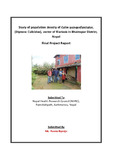Please use this identifier to cite or link to this item:
https://hdl.handle.net/20.500.14356/292Full metadata record
| DC Field | Value | Language |
|---|---|---|
| dc.contributor.author | Byanju, Reena | |
| dc.date.accessioned | 2012-12-29T04:08:12Z | |
| dc.date.accessioned | 2022-11-08T10:14:16Z | - |
| dc.date.available | 2012-12-29T04:08:12Z | |
| dc.date.available | 2022-11-08T10:14:16Z | - |
| dc.date.issued | 2012-12-28 | |
| dc.identifier.uri | http://103.69.126.140:8080/handle/20.500.14356/292 | - |
| dc.description.abstract | The present study was carried out from April- August 2011 in two sites viz Thapa Gaun of Jhaukhel VDC and Lama Tole of Nagarkot VDC, the sites being selected on the basis of altitudinal variation, with an objective of determining the population density of Culex quinquefasciatus, the filarial vector. 5 months research lead to the collection of total 3800 mosquitoes of different species (1479 from Thapa Gaun, Jhaukhel and 1196 from Lama Tole, Nagarkot). The laboratory identification resulted altogether 909 Cx. quinquefasciatus from indoor and outdoor collection, of which, 508 (55.89%) were from Jhaukhel and 401 (44.11%) were from Nagarkot. Similarly animal baited net trap collection included 1125 samples i.e. 346 from Jhaukhel and 779 from Nagarkot. On identification of the collected samples, it was found all total of 520 Cx. quinquefasciatus viz. 84 and 436 from Jhaukhel and Nagarkot respectively. Regarding indoor and outdoor collection, the highest density of the filarial vector was observed to be during July for both of the selected sites (26.09 for Nagarkot and 15.75 for Jhaukhel), while the least density was found to be in the month of April(0.165 for Jhaukhel and 0 for Nagarkot). Indoor density of Cx. quinquefasciatus was relatively higher than outdoor density which includes 54.75 indoor density and 17.25 outdoor density for Jhaukhel and 44.63 indoor density and 11 outdoor density for Nagarkot collection. Density of the vector in the human residence was lesser than in cattle viz. for Jhaukhel it was 19.25 for human collection and 90.25 for cattle collection and for Nagarkot it was calculated to be 26.75 for human and 62.5 for cattle. The population density of the vector was higher in the morning than in the evening viz. 54.67 for morning and 26.5 for evening of Jhaukhel and 33.5 morning density and 33.34 the evening density. Abdominal status showed increase number of fullfed (670) than unfed (211) and gravid (28) which included 391fullfed, 99 unfed and 18 gravid from Jhaukhel and 279 fullfed, 112 unfed and 10 gravid from Nagarkot which were relatively higher in indoor than in outdoor. Temperature and density were found to be associated with the density of filarial vector. The highest resting density for Jhaukhel and Nagarkot were observed in the month of May (7.73) and June (7.01) respectively while percentage abundance showed the peak value on July for both sites (12.75 for Jhaukhel and 26.17 for Nagarkot). Female Cx. quinquefasciatus were found to be relatively higher (875) than male (34). Out of total samples collected from animal bait net (520) the highest number was obtained during July for both sites(493 for Nagarkot and 60 for Jhaukhel). Unlike on July, no any samples were recorded from animal bait on the month of April. The present study conclude the presence of Cx. quinquefasciatus in both sites(Thapa Gaun of Jhaukhel and Lama Tole of Nagarkot) and the change in density was observed according to month and seasonal variability. | en_US |
| dc.language.iso | en_US | en_US |
| dc.subject | filariasis | en_US |
| dc.title | Study of population density of Culex quinquefasciatus, (Diptera: Culicidae), vector of filariasis in Bhaktapur District, Nepal | en_US |
| dc.type | Technical Report | en_US |
| Appears in Collections: | Post Graduate Grant (PG) Reports | |
Items in DSpace are protected by copyright, with all rights reserved, unless otherwise indicated.

